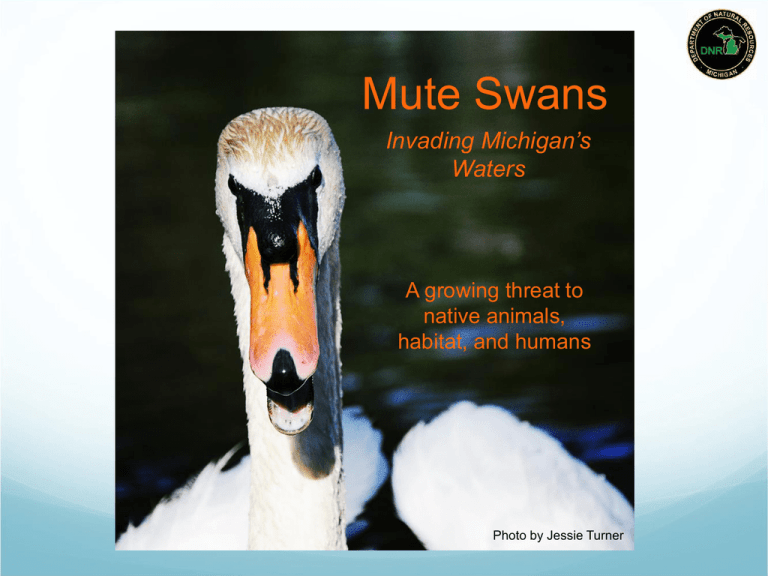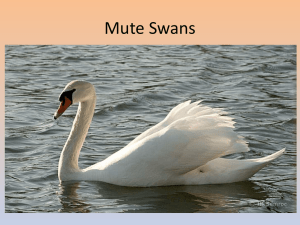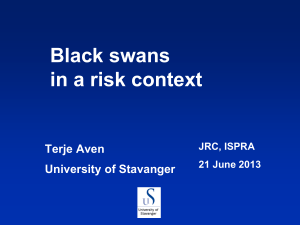
Mute Swans
Invading Michigan’s
Waters
A growing threat to
native animals,
habitat, and humans
Photo by Jessie Turner
Definitions
Native: species that occur naturally in a given area or
region
Non-Native: species that, due to direct or indirect human
activity, occurs in locations beyond its known historical
or potential natural range. Refers to species from
another continent, region, ecosystem, or habitat.
Invasive: non-native species that become established,
spread widely, and cause environmental or economic
harm or harm to human health
History of Mute Swans
in Michigan
Non-native and Invasive
Native to Eurasia
One pair introduced in Charlevoix
County in 1919
47 birds by 1949
A southern flock was later
established in SW Michigan
15,500 mute swans in 2010
Numbers increasing rapidly
All North American mute swans
Photo by Jessie Turner
originated from releases or escapes
Why are Mute Swans a
Problem?
Threaten humans
Endanger native wildlife
Destroy wetland habitat
Photo by Jessie Turner
Threaten Humans
Show little fear of people
Known to attack people in both
boats and on shore
Potentially dangerous conflicts
As mute swan populations
grow, so do conflicts
Nordic Photos/Superstock
Nik Taylor Photography
Endanger Native Wildlife
Mute swans are one of the world’s most aggressive waterfowl
Very territorial during nesting and raising of young
Drive out native waterfowl and other wetland bird species from
breeding areas
Birds at risk include state threatened trumpeter swan and
common loon; native ducks, and Canada geese
May be worse in areas where wetland loss has reduced suitable
waterfowl breeding habitat
Photo by http://www.thefreequark.com/
Destroy Wetland Habitat
A single mute swan can
consume 4-8 lbs. of
wetland plants a day
Sometimes uproot and
destroy plants completely
Wetland plants are
important in aquatic
ecosystems to provide food
and cover for native birds,
fish, and invertebrates
Photo by Mark Knee
Loss of native wetland
plants is detrimental to
the ecosystem
Michigan’s Swan Species
Photo courtesy of: US Fish &
Wildlife service
Photo byof:
Jessie
Turner
Photo courtesy
stockvault.net
Photo
Photo courtesy
courtesy of:
of: dreamstime.com
National Geographic
Trumpeter Swan
Mute Swan
Tundra Swan
Native
Non-native
Native
Trumpeter Swan
A Native Beauty
Native to Michigan
Threatened status
Mute swans threaten
breeding success
Photo by Jim Ridley
Mute Swan Numbers
Increasing Rapidly
Sauer, J. R., J. E. Hines, J. E. Fallon, K. L. Pardieck, D. J. Ziolkowski, Jr., and W. A. Link. 2011. The North American Breeding Bird Survey,
Results and Analysis 1966 - 2009. Version 3.23.2011 USGS Patuxent Wildlife Research Center, Laurel, MD
A Growing Problem
Population growth of about 9-10% annually
In 10 years, the number of mute swans has nearly tripled
Population model predicts 19,400-24,200 mute swans by 2015 if
we do nothing
Population
Michigan has the highest number of mute swans in North America
Year
Mute Swan Population Goals
Short-term goals (5-year):
Reduce the mute swan population to zero on DNR lands
Reduce the statewide mute swan population growth to
zero on all other lands
Long-term goal (20-year):
To maintain a spring population less than 2,000 mute
swans throughout Michigan
What is the DNR Doing?
Began local control activities in the 1960s due to a
growing concern of expanding mute swan numbers
Issue permits to remove mute swans and/or their nests
and eggs
Follow Wildlife-Division’s Mute Swan Management and
Control Program Policy and Procedures
Brought together a Mute Swan Forum
Mute Swan Management Efforts
Nest/egg destruction
Removal of birds
Both public and private lands
Photo by Jessie Turner
Why Remove Adults?
Population model suggests that removing adults is
most effective for reducing numbers
Adult survival has greatest impact on population growth
Mortality type
Number destroyed annually to stabilize
population
Nests destroyed
3,798
Eggs killed
18,990
Adults killed
1,485
Mute Swan Authorities
No protection under federal law
Not listed in Federal Migratory Bird Treaty Act
Protection removed in 2004 because not native
Under jurisdiction of states (Public Act 451 of 1994)
by Lori Niedenfuer Cool , Copyright 2007, The Grand Rapids Press. All rights reserved; used with permission.
Mute Swan State Authority
Wildlife Conservation Order
Protects mute swans
Mute swans and their eggs and nests may only be taken under one
of the following situations:
To stabilize or reduce population levels or prevent establishment of
new populations
To prevent interference with the establishment, reestablishment, or
reproductive success off native wildlife, threatened/endangered
species, and native vegetation
To protect public health, safety or welfare
Mute swans taken shall not be released back into the wild
Allows for issuance of damage and nuisance animal control permits
Hunting mute swans is not allowed
Support for Mute Swan
Management
There are many conservation groups that support the
drastic reduction of mute swan numbers
The National Audubon Society
The Michigan Audubon Society
Ducks Unlimited
The American Bird Conservancy
And many more!
What Can You Do?
You and your neighbors can help protect Michigan’s natural
resources, including the trumpeter swan, by controlling mute
swans on your lakes and wetlands.
Call your local DNR field office
Obtain nest/egg destruction or removal permits
For sites with multiple landowners, file a petition or resolution
Reaching mute swan goals is only possible with help
from local landowners
Thank you for
helping to protect
our native wildlife
species and
wetland habitat!
For more information visit
Trumpeter Swan
Photo by Bill Rollo
www.michigan.gov/muteswans







